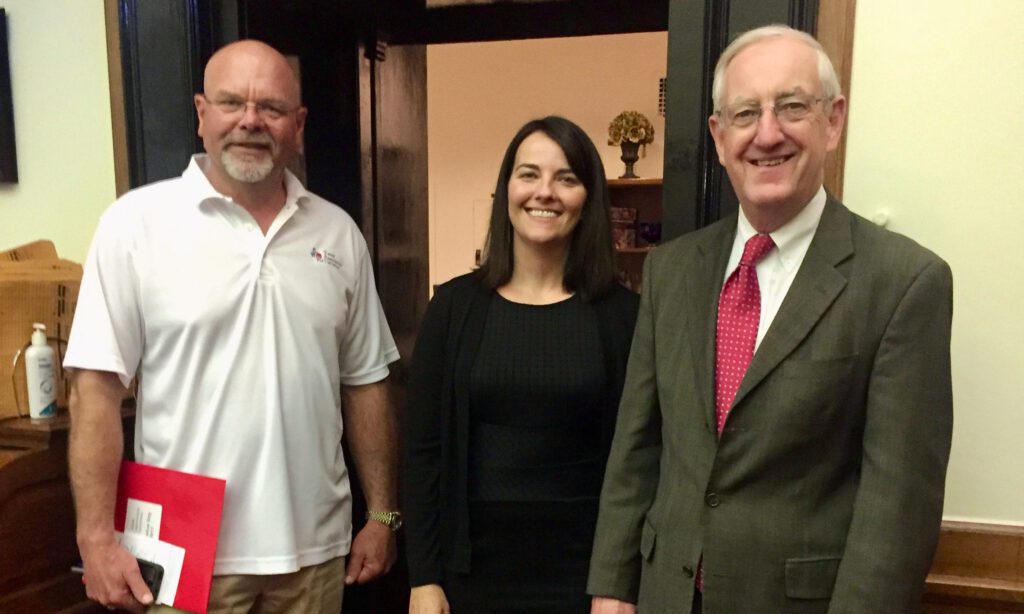
Return to September 2021 newsletter
Photo: Dairy farmer Willy De Jong (left), a longtime TAD board member, helps deliver the industry’s message at the Texas Capitol.
A Texas Dairy Farmer Reflects: The evolution of TAD and the dairy industry as TAD turns 30
The best way to chart the changes of the Texas Association of Dairymen during its history – and the evolution of the Texas dairy industry – is through the eyes of Texas dairy farmer Willy De Jong. De Jong has served two stints on the TAD board, first from 1994-2000 and then for the past five years. He owns and operates Hidden View Dairy in Dublin.
What inspired you to serve on the board, and then return to the board?
I have always tried to be involved in all aspects of my business. TAD was a young organization (when he first joined the board), and I felt I could contribute my time to shape decisions and directions the dairy industry in Texas were facing while positioning my farm to be able to take advantage of those changes. I came back on the board for those reasons and to try to work with the cities along the Bosque River to develop trust in the science and practices of how the industry handles the byproducts of producing milk, to not only produce healthier feed for our cows but to improve the soils with regenerative and other farming methods. I also felt strongly TAD needed a strong political action committee and have worked to make that a reality.
How has the Texas dairy industry changed during your years of service?
The Texas dairy industry is much larger today. Production per cow is much higher, but there are fewer of us. Back then, Central Texas, with few exceptions, was about as far west as the state’s milkshed went. Today the Panhandle is the milkshed of our state. The growth in milk plant capacity, size of farms and dairy farmers growing a higher percentage of the feed for our cows are the biggest changes. The issues are similar: public health, water, protecting the environment and good efficient roads to move our products to market have always been what TAD is about.
What were TAD’s primary issues when you first joined the board? How have those changed?
The Texas dairy industry was experiencing changes because of rapid growth. The milk flow was moving west, just like it is today. The issues are the similar, and the Texas dairy industry needs a strong voice in Austin. TAD is that organization. It is there every day telling the story and making sure every dairy farmer is represented. Not just at the Capitol, but at Texas AgriLife Extension Service, Texas Animal Health Commission, Texas Department of Agriculture and Texas Commission on Environmental Quality, to name a few agencies. I am proud of the way TAD has grown alongside the growth of our industry in Texas.
How has TAD’s perception at the Capitol changed during your board service?
When I first joined the TAD board, TAD was a reactionary organization. We were always behind the next crisis and did not have the funds to truly get our message out in Austin. Outside groups and municipalities that had no understanding what this growth in dairy meant to them and to our state had the voice. TAD’s perception in Austin and at state agencies was not good. We lacked the influence of other ag groups in Texas. Today TAD is respected, and not just in Austin. The cities that did not trust us now come to TAD to understand what dairy is doing to make our state a better place for us all to live. I am also proud of TAD’s leadership with the other ag groups today.
From your perspective as a dairy farmer, how does TAD benefit our state’s dairy farmers?
Agriculture is feeding more people every day and using fewer and fewer resources to do it. As a dairy farmer, we must have a place at the table where our laws are made. Ag is the best story in resource management, and that story need to be told. The TAD board and management are doing this every day so that all of us can continue to do what we love.


